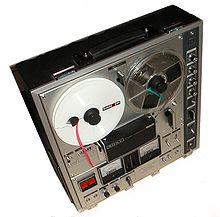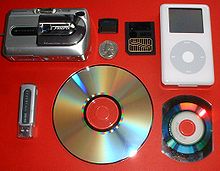Data storage
This article needs additional citations for verification. (February 2018) |




| Computer memory and computer data storage types |
|---|
| Volatile |
| Non-volatile |
Data storage is the recording (storing) of information (data) in a storage medium. Handwriting, phonographic recording, magnetic tape, and optical discs are all examples of storage media. Biological molecules such as RNA and DNA are considered by some as data storage.[1][2] Recording may be accomplished with virtually any form of energy. Electronic data storage requires electrical power to store and retrieve data.
Data storage in a digital, machine-readable medium is sometimes called digital data. Computer data storage is one of the core functions of a general-purpose computer. Electronic documents can be stored in much less space than paper documents.[3] Barcodes and magnetic ink character recognition (MICR) are two ways of recording machine-readable data on paper.
Recording media
[edit]A recording medium is a physical material that holds information. Newly created information is distributed and can be stored in four storage media–print, film, magnetic, and optical–and seen or heard in four information flows–telephone, radio and TV, and the Internet[4] as well as being observed directly. Digital information is stored on electronic media in many different recording formats.
With electronic media, the data and the recording media are sometimes referred to as "software" despite the more common use of the word to describe computer software. With (traditional art) static media, art materials such as crayons may be considered both equipment and medium as the wax, charcoal or chalk material from the equipment becomes part of the surface of the medium.
Some recording media may be temporary either by design or by nature. Volatile organic compounds may be used to preserve the environment or to purposely make data expire over time. Data such as smoke signals or skywriting are temporary by nature. Depending on the volatility, a gas (e.g. atmosphere, smoke) or a liquid surface such as a lake would be considered a temporary recording medium if at all.
Global capacity, digitization, and trends
[edit]A 2003 UC Berkeley report estimated that about five exabytes of new information were produced in 2002 and that 92% of this data was stored on hard disk drives. This was about twice the data produced in 2000. [5] The amount of data transmitted over telecommunication systems in 2002 was nearly 18 exabytes—three and a half times more than was recorded on non-volatile storage. Telephone calls constituted 98% of the telecommunicated information in 2002. The researchers' highest estimate for the growth rate of newly stored information (uncompressed) was more than 30% per year.
In a more limited study, the International Data Corporation estimated that the total amount of digital data in 2007 was 281 exabytes, and that the total amount of digital data produced exceeded the global storage capacity for the first time.[6]
A 2011 Science Magazine article estimated that the year 2002 was the beginning of the digital age for information storage: an age in which more information is stored on digital storage devices than on analog storage devices.[7] In 1986, approximately 1% of the world's capacity to store information was in digital format; this grew to 3% by 1993, to 25% by 2000, and to 97% by 2007. These figures correspond to less than three compressed exabytes in 1986, and 295 compressed exabytes in 2007.[7] The quantity of digital storage doubled roughly every three years.[8]
It is estimated that around 120 zettabytes of data will be generated in 2023[update], an increase of 60x from 2010, and that it will increase to 181 zettabytes generated in 2025.[9]
See also
[edit]- Archival science
- Blank media tax
- Computer data storage
- Computer memory
- Content format
- Data retention
- Data transmission
- Digital dark age
- Digital preservation
- Digital Revolution
- Disaggregated storage
- Distributed block storage
- Disk drive performance characteristics
- Disk storage
- Electronic quantum holography
- External storage
- Format war
- Flip-flop (electronics)
- Fuzzy bit
- Information Age
- IOPS
- Library
- Magnetic tape
- Media (communication)
- Media controls
- Medium format (film)
- Memristor
- Nanodot
- Nonlinear medium (random access)
- Plant-based digital data storage
- Recording format
- Semiconductor memory
- Software-defined storage
- Telecommunication
- Volatile memory
- Visual arts
References
[edit]- ^ a b Gilbert, Walter (Feb 1986). "The RNA World". Nature. 319 (6055): 618. Bibcode:1986Natur.319..618G. doi:10.1038/319618a0. S2CID 8026658.
- ^ Hubert, Bert (9 January 2021). "DNA seen through the eyes of a coder". Retrieved 12 September 2022.
- ^ Rotenstreich, Shmuel. "The Difference between Electronic and Paper Documents" (PDF). George Washington University. Archived from the original (PDF) on 20 February 2020. Retrieved 12 April 2016.
- ^ Lyman, Peter; Varian, Hal R. (October 23, 2003). "HOW MUCH INFORMATION 2003?" (PDF). UC Berkeley, School of Information Management and Systems. Archived from the original on December 8, 2017. Retrieved November 25, 2017.
- ^ Maclay, Kathleen (28 October 2003). "Amount of new information doubled in last three years, UC Berkeley study finds". University of California, Berkeley. Retrieved 2022-09-07.
- ^ Theirer, Adam (14 March 2008). "IDC's "Diverse & Exploding Digital Universe" report". Retrieved 2008-03-14.
- ^ a b Hilbert, Martin; López, Priscila (2011). "The World's Technological Capacity to Store, Communicate, and Compute Information". Science. 332 (6025): 60–65. Bibcode:2011Sci...332...60H. doi:10.1126/science.1200970. PMID 21310967. S2CID 206531385.
- ^ Hilbert, Martin (15 June 2011). "Video animation on The World's Technological Capacity to Store, Communicate, and Compute Information from 1986 to 2010". Archived from the original on 2012-01-18.
- ^ Duarte, Fabio (April 3, 2023). "Amount of Data Created Daily (2023)". Retrieved August 28, 2023.
Further reading
[edit]- Bennett, John C. (1997). "'JISC/NPO Studies on the Preservation of Electronic Materials: A Framework of Data Types and Formats, and Issues Affecting the Long Term Preservation of Digital Material". British Library Research and Innovation Report 50.
- History of Computer Data Storage
- History of Storage from Cave Paintings to Electrons
- The Evolution of Data Storage

